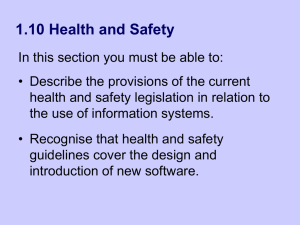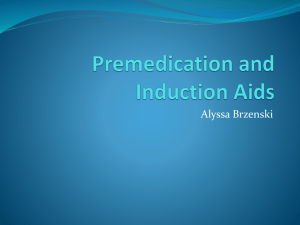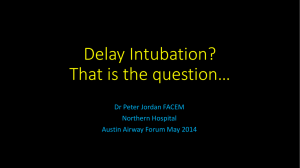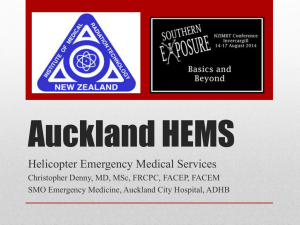Pre-hospital Rapid Sequence Induction and Intubation
advertisement
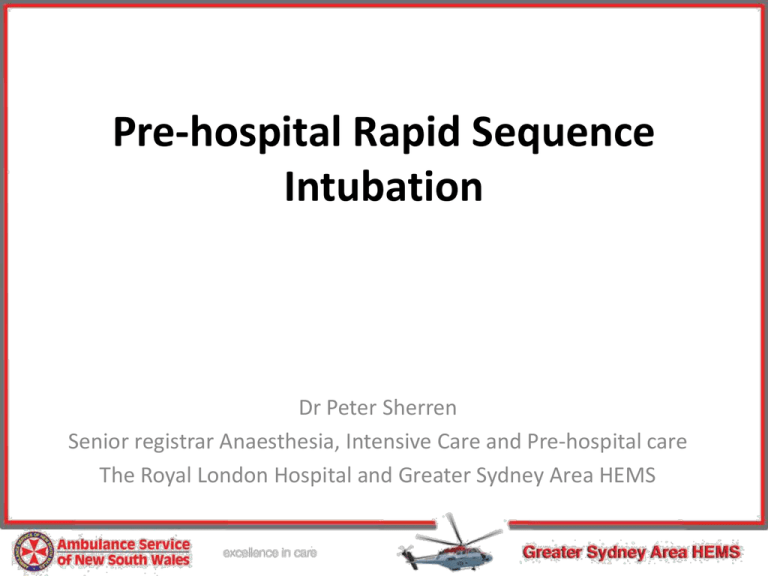
Pre-hospital Rapid Sequence Intubation Dr Peter Sherren Senior registrar Anaesthesia, Intensive Care and Pre-hospital care The Royal London Hospital and Greater Sydney Area HEMS Objectives • Why? • Who? • How? • Evidence Introduction • Controversial/Territorial/Evocative topic! • Early appropriate airway control central to good trauma care • Why not bring a hospital level of care to the roadside? Why? • Like haemorrhage, airway compromise is a significant cause of preventable deaths • Hypoxia common on scene in trauma. Stochetti et al. J Trauma 1997 • Hypoxia and hypercarbia associated with increased morbidity and mortality in TBI. Sherren PB et al. Curr Opin Anesthesiol 2012 • ETI is gold standard in hospital • Patient and pathology have no respect for geography How? - Intubation without drugs or sedation only • Successful ETI of trauma pts without drugs ~ mortality 99.8%. Lockey D et al. BMJ 2001. • Low success rates in patients with reflexes intact (5-30%) • ETI with sedation • Still a low success rate • ↑Secondary brain injury • ↑Mortality SOLUTION = RAPID SEQUENCE INTUBATION (RSI)? Components of RSI • • • • • • • • Preoxygenation Premedication Rapid induction of Anaesthesia MILS ± Cricoid Rapid onset neuromuscular relaxation Ideally no BVM ventilation ETI and confirmation Maintenance of Anaesthesia and paralysis Components of RSI • • • • • • • • Drug assisted definitive airway control Preoxygenation Premedication Rapid inductiontime of Anaesthesia Minimising from induction to ETI MILS ± Cricoid Rapid onset neuromuscular relaxation Decreased gastric insufflation Ideally no BVM ventilation ETI and confirmation Decreased risk of hypoxia and aspiration Maintenance of Anaesthesia and paralysis Controversies • Optional Premedictions • Sedate to preoxygenate (midazolam vs ketamine) • Opioid (Fentanyl 1-3mcg/kg) to obtund hypertensive response to laryngoscopy and ICP spikes • Fluid/blood bolus in hypovolaemic • Atropine in paeds • Induction agent? (much lower doses in hypovolaemic) • • • • • Midazolam (0.3mg/kg) Propofol (1.5-2.5mg/kg) Thiopentone (3-5mg/kg) Reconstitution, SVR issues Etomidate (0.3mg/kg) 11β/17α hydroxylase inhibition Ketamine (1-2mg/kg) CLOSE TO IDEAL AGENT Controversies • Optional Premedictions • Sedate to preoxygenate (midazolam vs ketamine) • Opioid (Fentanyl 1-3mcg/kg) to obtund hypertensive response to laryngoscopy and ICP spikes • Fluid/blood bolus in hypovolaemic • Atropine in paeds • Induction agent? (much lower doses in hypovolaemic) • • • • • Midazolam (0.3mg/kg) Propofol (1.5-2.5mg/kg) Thiopentone (3-5mg/kg) Reconstitution, SVR issues Etomidate (0.3mg/kg) 11β/17α hydroxylase inhibition Ketamine (1-2mg/kg) CLOSE TO IDEAL AGENT Controversies • Neuromuscular blockade • Suxamethonium (1.5-2mg/kg) – Rapid, familiarity and obvious fasciculation end point but dirty drug • Rocuronium (1.2mg/kg) – Rapid, improved side effect profile and prolonged safe apnoea time • Cricoid pressure - poor evidence & ↑ Difficult intubation. Harris T et al. Resuscitation 2010 Bottom line • Generally right drug, at the right time, at the right dose……… • Pre-hospital=high risk → Simplified evidence based Standard Operating Procedures (SOP) • Remove individual practice in high risk environment, improve CRM and reduce human error Not controversial • Pre-hospital environment is no excuse for low standards of care • Rigorous training, simulation, assessment and currencies • Trained operator and assistant • AAGBI standard of monitoring (ECG, NiBP, SpO2, waveform ETCO2) • Quality control/assurance as part of good clinical governance • Preoxygenation • Non-rebreath mask or BVM ± PEEP valve • Nasal cannula oxygen 15L/min. PreO2 + DAO • Consider OPA/NPAx2/SGA Still not controversial • MILS - remove C-collar • Maximise 1st pass intubation success • • • • • Control your environment 360 degree access Optimise position Use bougie for all cases Standardised equipment and techniques • Formalised failed intubation and oxygenation drills Who? • • • • Impending or actual failure of airway patency Failure of airway protection Oxygenation or ventilation failure Injured patients who are unmanageable or severely agitated after head injury • Humanitarian indications • Anticipated clinical course So we think pre-hospital RSI has a place, but who should be doing it? ↓ A TRAINED AND COMPETENT TEAM Physician-paramedic team • Good medical experience • Anaesthetic experience • Doctor ≠ pre-hospital RSI competent! • Additional pre-hospital training • Cost • Availability Double Paramedic or paramedic/air crewman • At home in the prehospital environment • Experienced++ • Infrastructure and governance needed • Infrequent occurrence for those purely working out of hospital; skill maintenance issue Do paramedics want to do it? • 99 London HEMS paramedics were asked if they felt RSI should be part of experienced UK paramedic’s practice (courtesy of Prof D Lockey) • 65% said yes pre-term at London HEMS • Only 32% said yes on completion of their term working for HEMS • Isolated to London HEMS? Success rates of pre-hospital RSI • Physician/paramedic team • • • • • 99.4% London HEMS (348/350) Mackay CA et al. Emerg Med J 2001 98.8% London HEMS (397/402) Harris T et al. Resuscitation 2010 99.5% GSA-HEMS (185/186) Bloomer R et al. Emerg Med J 2012 99.1% SAMU France (685/691) Adnet F et al. Ann Emerg Med 1998 100% Germany (342/342) Helm M et al. Br J Anaesth 2006 • Paramedic • 97% MICA Victoria (152/157) Bernard SA et al. Ann Surg 2010 • 96% Auckland rescue helicopter (~280) Tony Smith • 86.7% San Diego (281/209) Davis DP et al. J Trauma 2003 Are failed intubations an issue? • Yes, but.... • Can’t Intubate Can’t Oxygenate much worse • Failure to detect an oesophageal intubation or misplaced ETT is much worse • Undetected oesophageal intubations during RSI should really be a ‘NEVER’ event • Continuous ETCO2 monitoring reduces UNDETECTED misplaced intubations from 23.3% to 0%. Silvestri S et al. Ann Emerg Med 2005 Waveform capnography/ETCO2 • • • • • • • • 209 RSI, 627 historical controls Mortality - RSI vs control, 33% vs 24% (p <0.05) Good outcome – RSI vs control, 57% vs 45% (p <0.01) High rates of hypotension, hypoxaemia, hypercarbia Low intubation success Longer scene times Training issue? Use of ETCO2 not universal • • • • 312 pts RCT MICA paramedics with ETCO2 Midazolam/Sux 97% success rate, 5 oesophageal intubations recognised • Favourable outcome - 51% pre-hospital RSI compared 39% controls (p <0.05) • 13 lost to follow up, 1 more +ve outcome in control group would result in NS result • Prospective RCT by Careflight, awaiting publication • Physician/paramedic vs standard care • 338 recruited over 6yrs, needed 510 pts • -ve primary outcome (GOSE 6 months) • High cross over between groups • When ASNSW physician/paramedic team added to careflight team data -> improved odds of survival at discharge (p-0.02) Pre-hospital RSI is here to stay, so how do we make it safer? PRE-HOSPITAL RSI ↓ KEEP IT SIMPLE ↓ STANDARDISE PRACTICE (equipment, techniques and drugs) ↓ AVOID HUMAN ERROR ↓ IMPROVE CRM Standard Operating procedures Standardised pre-hospital drugs • Pre-drawn drugs • • • • Ketamine 200mg/20ml Suxamethonium 100mg/2ml (x2) Midazolam 10mg/10ml Morphine 10mg/10ml • Spare Ampoules • • • • Rocuronium 50mg/5ml (x2) Fentanyl 500mcg/10ml (x2) Midazolam 15mg/3ml Ketamine 200mg/2ml (x5) In hospital level of monitoring and Kit dump Challenge response checklist Quality assurance and clinical governance Training and simulation Summary • Pre-hospital RSI is indicated in certain patients • High risk intervention that needs to be delivered in a quality assured manner • Pre-hospital RSI done badly is worse than standard management • Some evidence for a morbidity and mortality benefit Questions?






